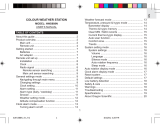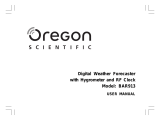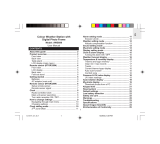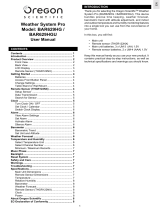Auriol Z31130 Operation and Safety Notes
- Kategori
- Väderstationer
- Typ
- Operation and Safety Notes

Z31130
FUNK-WETTERSTATION
Bedienungs- und Sicherheitshinweise
RADIO-CONTROLLED WEATHER STATION
Operation and Safety Notes
RADIOSTYRD VÄDERSTATION
Bruksanvisning och säkerhetsanvisningar
RADIO-OHJATTU SÄÄASEMA
Käyttö- ja turvallisuusohjeet
RADIOSTYRET VEJRSTATION
Brugs- og sikkerhedsanvisninger
85059_aur_DCF-Wetterstation_Cover_LB3.indd 4 02.01.13 07:26

GB / IE Operation and Safety Notes Page 7
FI Käyttö- ja turvallisuusohjeet Sivu 41
SE Bruksanvisning och säkerhetsanvisningar Sidan 76
DK Brugs- og sikkerhedsanvisninger Side 110
DE / AT / CH Bedienungs- und Sicherheitshinweise Seite 145
85059_aur_DCF-Wetterstation_Cover_LB3.indd 5 02.01.13 07:26

3
A
7
8
9
17
19
15
13
11
10
20
16
18
14
12
1 2 3 4 5
22232627 25 24 21
6
85059_aur_DCF-Wetterstation_Content_LB3.indd 3 02.01.13 07:28

4
B
28
30
32
31
29
33
85059_aur_DCF-Wetterstation_Content_LB3.indd 4 02.01.13 07:28

5
C
40
34 35 36 37 38 39
85059_aur_DCF-Wetterstation_Content_LB3.indd 5 02.01.13 07:28

6
D
42
43
44
45
41
85059_aur_DCF-Wetterstation_Content_LB3.indd 6 02.01.13 07:28

7 GB/IE
Intended use ..........................................................................................Page 9
Parts description ................................................................................Page 9
Technical data .......................................................................................Page 11
Included items ......................................................................................Page 12
Safety
General Safety Information .........................................................................Page 13
Safety Instructions for Batteries ...................................................................Page 14
Before use
Setting up the devices ..................................................................................Page 15
Preparing to use the outdoor sensor ...........................................................Page 16
Preparing the weather station for use ......................................................... Page 17
Operation
Receiving the DCF radio time signal ...........................................................Page 19
Setting the 12 / 24 hour mode / °C / °F / hPa / inHg / time
zone / time / date / language manually ......................................................Page 20
Setting the alarm time ..................................................................................Page 22
Activating / deactivating the alarm function ............................................... Page 23
Switching off the alarm signal ..................................................................... Page 23
85059_aur_DCF-Wetterstation_Content_LB3.indd 7 02.01.13 07:28

8 GB/IE
SNOOZE function .......................................................................................Page 23
Preparing to use the weather forecasting function .....................................Page 24
Selecting the location ...................................................................................Page 26
Selecting the location manually ..................................................................Page 26
Lunar phases.................................................................................................Page 30
Reading the barometric pressure for the last 12 hours .............................Page 30
Adjusting the air pressure indication ...........................................................Page 31
Setting the channel .......................................................................................Page 32
Displaying temperature and temperature trend .........................................Page 33
Displaying the humidity and humidity trend ...............................................Page 33
Displaying the maximum / minimum temperature / humidity .....................Page 34
Temperature and frost alarm .......................................................................Page 35
Activating / deactivating the the temperature and frost alarm .................. Page 35
Background lighting .....................................................................................Page 36
Battery state display .....................................................................................Page 36
Changing the batteries ................................................................................Page 36
Troubleshooting .................................................................................Page 37
Cleaning and care .............................................................................Page 38
Disposal ..................................................................................................... Page 39
Information
Declaration of Conformity ........................................................................... Page 40
85059_aur_DCF-Wetterstation_Content_LB3.indd 8 02.01.13 07:28

9 GB/IE
Radio-controlled weather station
Intended use
The weather station displays the indoor and outdoor temperatures in Celsius (°C) or
Fahrenheit (°F) and their maximum and minimum values. It also displays the indoor and
outdoor humidity (%RH) as well as their maximum and minimum values. Additional
display values of weather station include the weather forecast, the time in 12 / 24-hour
clock modes and the date. The weather station displays the sunrise and sunset times
for that day and the lunar phase as well. In addition, the weather station has two
different alarm functions. The device is not intended for commercial use.
Parts description
Weather station:
1
Date display
2
Month display
3
Alarm 1
4
SNOOZE display
5
Radio tower symbol
6
DST display (summer time)
7
Time display
85059_aur_DCF-Wetterstation_Content_LB3.indd 9 02.01.13 07:28

10 GB/IE
8
Alarm 2
9
Day of week display
10
Sunrise / time of sunrise
11
Tide display
12
Location
13
Lunar phase
14
Sundown / time of sundown
15
Temperature trend (indoor)
16
Humidity trend (indoor)
17
Humidity (indoor)
18
Comfort indicator (maximum / minimum)
19
Inside temperature (°C / °F)
20
Battery state display
21
Humidity trend (outdoor)
22
Humidity (outdoor)
23
Temperature and frost alarm (maximum / minimum)
24
Temperature trend (outdoor)
25
Outdoor temperature (°C / °F)
26
Battery state display (outdoor sensor)
27
Selected channel
28
Barometric pressure bar display
29
Barometric pressure display of the last hour
30
Absolute / relative barometric pressure
31
Barometric pressure trend
85059_aur_DCF-Wetterstation_Content_LB3.indd 10 02.01.13 07:28

11 GB/IE
32
Weather forecast
33
SNOOZE / LIGHT button
34
MODE button
35
+ button
36
– button
37
Channel button (CH)
38
HISTORY ABS / REL button
39
CITY button
40
Battery compartment
Outdoor sensor:
41
Control LED
42
Mount
43
RESET button
44
Channel selector switch
45
Battery compartment
Technical data
Weather station:
Temperature measurement range: 0 to +50 °C
+32 to +122 °F
Temperature resolution: 0.1 °C
85059_aur_DCF-Wetterstation_Content_LB3.indd 11 02.01.13 07:28

12 GB/IE
Humidity measurement range: 20 %–95 %
Humidity resolution: 1 %
Radio signal: DCF
Batteries: 3 x AA, 1.5 V
Dimensions: 130 x 130 x 60 mm (B x H x D)
Air pressure range: 850 - 1050 hPa
Outdoor sensor:
Temperature measurement range: –20 to +65 °C
–4 to +149 °F
Humidity measurement range: 20 %–95 %
Humidity resolution: 1 %
HF transmission signal: 433 MHz
HF transmission range: max. 30 metres (in open area)
Batteries: 2 x AA, 1.5 V
Dimensions: 46 x 105 x 28 mm
Included items
1 Weather station
1 Outdoor sensor
3 Batteries AA, 1.5 V
85059_aur_DCF-Wetterstation_Content_LB3.indd 12 02.01.13 07:28

13 GB/IE
2 Batteries AA, 1.5 V
1 Operating instructions
Safety
Please read all safety information and instructions. Failure to comply with the safety
information and instructions may result in an electric shock, fire and / or severe injuries.
KEEP ALL THE SAFETY ADVICE AND INSTRUCTIONS IN A SAFE PLACE FOR
FUTURE REFERENCE!
General Safety Information
Children frequently underestimate the dangers.
Children should be kept away from the product at all times.
Children or other individuals who do not know or have no experience of handling
this device, or whose physical, sensory or mental abilities are restricted, must
not use the device without supervision or instruction by an individual responsible
for their safety. Children must never be allowed to play with the device.
Do not use the device if it is damaged.
85059_aur_DCF-Wetterstation_Content_LB3.indd 13 02.01.13 07:28

14 GB/IE
Safety Instructions for Batteries
DANGER TO LIFE! Batteries can be swallowed, which may represent a danger
to life. If a battery has been swallowed, medical help is required immediately.
Remove the batteries from the device if they have not been used for a long period.
CAUTION! DANGER OF EXPLOSION! The batteries must never be
recharged!
When inserting the battery, ensure the correct polarity! This is shown in the
battery compartments.
If necessary, clean the contacts on the batteries and on the device before
inserting them.
Remove spent batteries from the device immediately. There is an increased
danger of leaks!
Batteries must not be disposed of in the normal domestic waste!
Every consumer is obliged to dispose of batteries properly in accordance with
the regulations!
Keep batteries away from children. Do not throw batteries into a fire. Never
short-circuit them or take them apart.
Always replace all the batteries at the same time.
Use only batteries of the same type.
If the batteries in your device have leaked, remove them immediately to prevent
damage to the device!
85059_aur_DCF-Wetterstation_Content_LB3.indd 14 02.01.13 07:28

15 GB/IE
Avoid contact with the skin, eyes and mucous membranes. In the event of contact
with fluid leaking from a battery, thoroughly flush the affected area with water
and / or seek the advice of a doctor!
Before use
Setting up the devices
Put the batteries first into the outdoor sensor.
CAUTION! When choosing where to position the weather station, make sure
that it is not exposed to direct sunlight, vibrations, dust, heat, cold or moisture. Do
not place the devices close to sources of heat, e.g. radiators. Otherwise they may
be damaged.
Do not place the devices on valuable or sensitive surfaces unless these are
appropriately protected. Otherwise they may be damaged.
Please ensure that neighbouring devices are not operated at the same frequency
of 433 MHz. Such devices may cause interference to the radio connection.
Do not place the devices next to or on metal plates. Otherwise the quality of
radio wave transmission may be reduced.
85059_aur_DCF-Wetterstation_Content_LB3.indd 15 02.01.13 07:28

16 GB/IE
Do not install the devices in buildings made of reinforced concrete, e.g. airports,
high-rise buildings, factories or cellars. Otherwise the transmission of the radio
waves between the devices may be severely impaired.
Preparing to use the outdoor sensor
Remove the battery compartment cover from the back of the outdoor sensor.
Remove the battery safety strip. The outdoor sensor is now ready for operation
and the control LED
41
lights up briefly.
Note: If you use more than one outdoor sensor (max. 3), you can receive data
at the weather station from all the individual outdoor sensors. Set a different
channel for each of the sensors using the channel selector switch
44
.
Close the battery compartment cover.
Installing the Outdoor Sensor:
Note: You will need an electric drill for this step.
Find an appropriate place for the outdoor sensor.
Note: Please ensure that you install the outdoor sensor within a radius of 30 m
from the weather station. Check that there are no obstacles between the outdoor
sensor and the weather station. Otherwise there may be interference of the
transmission of data.
85059_aur_DCF-Wetterstation_Content_LB3.indd 16 02.01.13 07:28

17 GB/IE
For wall mounting:
Hang the outdoor sensor with the mount
42
on one screw.
Preparing the weather station for use
Removing the battery safety strip:
Open the battery compartment
40
on the back of the weather station.
Pull out the battery safety strip.
Then close the battery compartment.
As soon as the battery safety strip has been removed, the weather station starts to
receive the radio signal.
Note: Do not move the weather station while it is receiving the signal. This may
disrupt reception.
Connecting the weather station with the outdoor sensor and the
DCF radio signal:
After removal of the battery safety strip the weather station attempts to establish a
connection with the outdoor sensor. This process can take a few minutes. On successful
connection with the outdoor sensor, the selected channel symbol
27
appears in the
LC display with the channel of the outdoor sensor (if necessary you can change the
channel of the outdoor sensor as shown in the section “Setting the channel”). If the
85059_aur_DCF-Wetterstation_Content_LB3.indd 17 02.01.13 07:28

18 GB/IE
connection with the outdoor sensor is not established automatically, this can be done
manually by pressing RESET button
43
of the sensor.
As soon as the weather station has established a connection with the outdoor sensor
it automatically begins to receive the DCF radio signal. This process takes several
minutes and is indicated in the LC display by a flashing radio tower symbol
5
.
When the DCF radio signal is being successfully received, the radio tower symbol
is shown permanently in the display. If at the time of putting the device into opera-
tion it is not possible to synchronise with the atomic clock, you can also carry out
the clock adjustments manually (“Setting the 12 / 24 hour mode / °C / °F / hPa /
inHg / time zone / time / date / language manually”).
Radio signal (DCF):
The DCF signal (time signal transmitter) consists of time pulses emitted by one of
the most accurate clocks in the world close to Frankfurt / Main, Germany.
In ideal conditions, your weather station can pick up this signal over a distance of
up to approx. 2000 km around Frankfurt / Main. Reception of the radio signal
generally takes approx. 3–10 minutes.
Reception can be considerably impaired by obstacles (e.g. concrete walls) or sources
of interference (e.g. other electrical devices). In the event of reception problems,
change the position of the weather station (e.g. to somewhere near a window).
85059_aur_DCF-Wetterstation_Content_LB3.indd 18 02.01.13 07:28

19 GB/IE
Operation
Receiving the DCF radio time signal
After a connection with the outdoor sensor is established or 3 minutes after the battery
safety strip is removed, the weather station automatically begins to search for the
DCF radio signal. The search is shown in the LC display by the radio tower symbol
5
flashing.
Note: In buildings made of reinforced concrete the reception of the radio signal
may be severely impaired (see “Setting up the devices”).
In order to correct any deviations from the exact time, the clock is automatically
synchronised with the DCF radio signal every day at 1:00, 2:00 and 3:00.
Reception of the DCF radio signal can also be started manually on the weather station.
Press the + or – button
35
,
36
at the same time. The weather station attempts to
receive the DCF radio signal. This process takes several minutes and is indicated
in the LC display by a flashing radio tower symbol.
If the connection with the DCF radio signal cannot be established, the search is
stopped.
Note: If the clock of the weather station cannot receive the DCF radio signal due
to errors, too great a distance from the transmitter or similar reasons, it is possible
to set the time manually. If reception of the DCF signal is successful, the manual
settings are overwritten.
85059_aur_DCF-Wetterstation_Content_LB3.indd 19 02.01.13 07:28

20 GB/IE
Setting the 12 / 24 hour mode / °C / °F / hPa / inHg /
time zone / time / date / language manually
The reception of DCF radio signal where the weather station has been positioned may
become degraded or interrupted. If this happens you can set the device manually.
Follow these steps:
1.
Press and hold down the MODE button
34
for about 3 seconds. “12 Hr” or “24 Hr”
blinks in the display. Press the + or – button
35
,
36
to choose the desired hour
format.
Note: The AM symbol in the time display
7
stands for before noon in the
12 hour mode. The PM symbol in the time display stands for after noon in
12 hour mode.
2. Confirm your setting by pressing the MODE button. The temperature unit “°C “
or “°F” flashes in the display. Press the + or – button to choose the desired
temperature unit.
3. Confirm your setting by pressing the MODE button. The barometric pressure’s
unit flashes in the display. Press the + or – button to set the desired unit (hPa /
inHg).
4. Confirm your setting by pressing the MODE button. The time zone indicator
flashes in the display. Press the + or – button to set the desired value (-2 to +2).
Note: The standard setting for the time zone is GMT+1. Set the weather station
to correspond to your time zone.
85059_aur_DCF-Wetterstation_Content_LB3.indd 20 02.01.13 07:28
Sidan laddas...
Sidan laddas...
Sidan laddas...
Sidan laddas...
Sidan laddas...
Sidan laddas...
Sidan laddas...
Sidan laddas...
Sidan laddas...
Sidan laddas...
Sidan laddas...
Sidan laddas...
Sidan laddas...
Sidan laddas...
Sidan laddas...
Sidan laddas...
Sidan laddas...
Sidan laddas...
Sidan laddas...
Sidan laddas...
Sidan laddas...
Sidan laddas...
Sidan laddas...
Sidan laddas...
Sidan laddas...
Sidan laddas...
Sidan laddas...
Sidan laddas...
Sidan laddas...
Sidan laddas...
Sidan laddas...
Sidan laddas...
Sidan laddas...
Sidan laddas...
Sidan laddas...
Sidan laddas...
Sidan laddas...
Sidan laddas...
Sidan laddas...
Sidan laddas...
Sidan laddas...
Sidan laddas...
Sidan laddas...
Sidan laddas...
Sidan laddas...
Sidan laddas...
Sidan laddas...
Sidan laddas...
Sidan laddas...
Sidan laddas...
Sidan laddas...
Sidan laddas...
Sidan laddas...
Sidan laddas...
Sidan laddas...
Sidan laddas...
Sidan laddas...
Sidan laddas...
Sidan laddas...
Sidan laddas...
Sidan laddas...
Sidan laddas...
Sidan laddas...
Sidan laddas...
Sidan laddas...
Sidan laddas...
Sidan laddas...
Sidan laddas...
Sidan laddas...
Sidan laddas...
Sidan laddas...
Sidan laddas...
Sidan laddas...
Sidan laddas...
Sidan laddas...
Sidan laddas...
Sidan laddas...
Sidan laddas...
Sidan laddas...
Sidan laddas...
Sidan laddas...
Sidan laddas...
Sidan laddas...
Sidan laddas...
Sidan laddas...
Sidan laddas...
Sidan laddas...
Sidan laddas...
Sidan laddas...
Sidan laddas...
Sidan laddas...
Sidan laddas...
Sidan laddas...
Sidan laddas...
Sidan laddas...
Sidan laddas...
Sidan laddas...
Sidan laddas...
Sidan laddas...
Sidan laddas...
Sidan laddas...
Sidan laddas...
Sidan laddas...
Sidan laddas...
Sidan laddas...
Sidan laddas...
Sidan laddas...
Sidan laddas...
Sidan laddas...
Sidan laddas...
Sidan laddas...
Sidan laddas...
Sidan laddas...
Sidan laddas...
Sidan laddas...
Sidan laddas...
Sidan laddas...
Sidan laddas...
Sidan laddas...
Sidan laddas...
Sidan laddas...
Sidan laddas...
Sidan laddas...
Sidan laddas...
Sidan laddas...
Sidan laddas...
Sidan laddas...
Sidan laddas...
Sidan laddas...
Sidan laddas...
Sidan laddas...
Sidan laddas...
Sidan laddas...
Sidan laddas...
Sidan laddas...
Sidan laddas...
Sidan laddas...
Sidan laddas...
Sidan laddas...
Sidan laddas...
Sidan laddas...
Sidan laddas...
Sidan laddas...
Sidan laddas...
Sidan laddas...
Sidan laddas...
Sidan laddas...
Sidan laddas...
Sidan laddas...
Sidan laddas...
Sidan laddas...
Sidan laddas...
Sidan laddas...
Sidan laddas...
Sidan laddas...
Sidan laddas...
Sidan laddas...
Sidan laddas...
Sidan laddas...
Sidan laddas...
Sidan laddas...
Sidan laddas...
-
 1
1
-
 2
2
-
 3
3
-
 4
4
-
 5
5
-
 6
6
-
 7
7
-
 8
8
-
 9
9
-
 10
10
-
 11
11
-
 12
12
-
 13
13
-
 14
14
-
 15
15
-
 16
16
-
 17
17
-
 18
18
-
 19
19
-
 20
20
-
 21
21
-
 22
22
-
 23
23
-
 24
24
-
 25
25
-
 26
26
-
 27
27
-
 28
28
-
 29
29
-
 30
30
-
 31
31
-
 32
32
-
 33
33
-
 34
34
-
 35
35
-
 36
36
-
 37
37
-
 38
38
-
 39
39
-
 40
40
-
 41
41
-
 42
42
-
 43
43
-
 44
44
-
 45
45
-
 46
46
-
 47
47
-
 48
48
-
 49
49
-
 50
50
-
 51
51
-
 52
52
-
 53
53
-
 54
54
-
 55
55
-
 56
56
-
 57
57
-
 58
58
-
 59
59
-
 60
60
-
 61
61
-
 62
62
-
 63
63
-
 64
64
-
 65
65
-
 66
66
-
 67
67
-
 68
68
-
 69
69
-
 70
70
-
 71
71
-
 72
72
-
 73
73
-
 74
74
-
 75
75
-
 76
76
-
 77
77
-
 78
78
-
 79
79
-
 80
80
-
 81
81
-
 82
82
-
 83
83
-
 84
84
-
 85
85
-
 86
86
-
 87
87
-
 88
88
-
 89
89
-
 90
90
-
 91
91
-
 92
92
-
 93
93
-
 94
94
-
 95
95
-
 96
96
-
 97
97
-
 98
98
-
 99
99
-
 100
100
-
 101
101
-
 102
102
-
 103
103
-
 104
104
-
 105
105
-
 106
106
-
 107
107
-
 108
108
-
 109
109
-
 110
110
-
 111
111
-
 112
112
-
 113
113
-
 114
114
-
 115
115
-
 116
116
-
 117
117
-
 118
118
-
 119
119
-
 120
120
-
 121
121
-
 122
122
-
 123
123
-
 124
124
-
 125
125
-
 126
126
-
 127
127
-
 128
128
-
 129
129
-
 130
130
-
 131
131
-
 132
132
-
 133
133
-
 134
134
-
 135
135
-
 136
136
-
 137
137
-
 138
138
-
 139
139
-
 140
140
-
 141
141
-
 142
142
-
 143
143
-
 144
144
-
 145
145
-
 146
146
-
 147
147
-
 148
148
-
 149
149
-
 150
150
-
 151
151
-
 152
152
-
 153
153
-
 154
154
-
 155
155
-
 156
156
-
 157
157
-
 158
158
-
 159
159
-
 160
160
-
 161
161
-
 162
162
-
 163
163
-
 164
164
-
 165
165
-
 166
166
-
 167
167
-
 168
168
-
 169
169
-
 170
170
-
 171
171
-
 172
172
-
 173
173
-
 174
174
-
 175
175
-
 176
176
-
 177
177
-
 178
178
-
 179
179
-
 180
180
-
 181
181
-
 182
182
Auriol Z31130 Operation and Safety Notes
- Kategori
- Väderstationer
- Typ
- Operation and Safety Notes
på andra språk
- Deutsch: Auriol Z31130
- English: Auriol Z31130
- dansk: Auriol Z31130
- suomi: Auriol Z31130
Relaterade papper
-
Auriol Z31130 Operation and Safety Notes
-
Auriol 291528 Operation and Safety Notes
-
Auriol Z30398 Bruksanvisning
-
Auriol Z29962A Operation and Safety Notes
-
Auriol Z31055A Operation and Safety Notes
-
Auriol Z31408A Operation and Safety Notes
-
Auriol 270302 Operation and Safety Notes
-
Auriol 79210 Operation and Safety Notes
-
Auriol 4-LD3091 Användarmanual
-
Auriol 283736 Operation and Safety Notes
Andra dokument
-
Hama 00186369 Bruksanvisning
-
 Oregon Scientific AWS888N Bruksanvisning
Oregon Scientific AWS888N Bruksanvisning
-
 Oregon Scientific BAR913 Bruksanvisning
Oregon Scientific BAR913 Bruksanvisning
-
 Oregon Scientific AWS899 Bruksanvisning
Oregon Scientific AWS899 Bruksanvisning
-
 Oregon Scientific BAR 310HG Användarmanual
Oregon Scientific BAR 310HG Användarmanual
-
 Oregon Scientific BAR629HG / BAR629HGU Användarmanual
Oregon Scientific BAR629HG / BAR629HGU Användarmanual
-
National Geographic IN102TOP Användarmanual
-
TFA Dostmann 35.1111.IT Användarmanual
-
Hama 00186369 Meteotime Weather Forecast Centre Användarmanual
-
Trotec BZ05 Operating Instructions Manual


























































































































































































